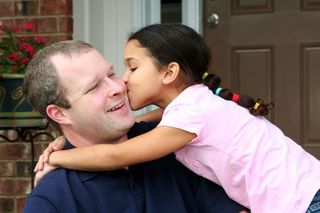
Mating
Biracial Dating in a Monoracial Culture
One expert explores the dating experiences of biracial individuals.
Posted June 14, 2017
While I’ve never actually seen the film, the theme song was a staple of our household in my early years.
I've got jungle fever, she's got jungle fever
We've got jungle fever, we're in love
She's gone black-boy crazy, I've gone white-girl hazy
Ain't no thinking maybe, we're in love
~ Jungle Fever, Stevie Wonder
My father—African American—would burst out in song, as he danced around my White mother, teasingly highlighting the stark differences in their cultural backgrounds.
We often hear about the challenges of interracial couples from a binary cultural narrative, that is, questions are posed to the white partner who has suddenly found himself dating a non-white partner:
- “How did your (White) family react when they knew you were dating a Black chick?”
- “Have you always been attracted to (insert generic POC label here)?”
- “He’s bangin! What’s it like to date someone so exotic?”
Or, alternately, there are the historically-laden themes that arise when a person of color decides to date outside of tribe by taking up with a caucasian partner. The person of color often faces real (or internalized) accusations of betraying one’s people, selling out, or serving as an object of fantasy.
But rarely, if ever, do we hear about the experiences that biracial individuals face when diving into the dating world. The romantic stories of people who don’t quite identify with the black and white binary that dominates the American narrative often go unrepresented.
This is why I was eager to sit down with Alexandra P. Jamali, a Berkeley-based psychotherapist who specializes in working with multiethnic individuals who are navigating romantic relationships. Through her work, Jamali has discovered that biracial people have a unique lens that they bring to the dating world, which can be both a blessing and a curse when entering into relationships with white partners.

“A lot of our early dynamics can get stirred up in relationships and cause some hiccups and places where we can get stuck.” Jamali says. “Taking the sociocultural dynamics that come up with mixed race experiences into the equation adds a deeper level of understanding to the work.”
According to Jamali, “People who are biracial and have a white parent often don’t have an ‘us and them dynamic’ such that racial splitting is experienced in a different way, often depending on which parent’s narrative is at the fore.This adds a layer of nuance and complexity to issues of difference.”
Racial splitting is often unconscious. It happens outside of our awareness. A White person raised in predominantly White spaces may see an Asian individual and, in some unconscious way, relate to that person as “not me.” Or, alternately, an African American person, who was raised to identify strongly as "Black" could be in a room filled with White individuals and feel like this space is not for them.
But for biracial individuals, especially where one parent is of dominant White culture and another parent is from a minority culture—the act of splitting others into “like me” or “different than me” based on racial identifiers is much more complex.
In the U.S. where conversations around race are so often split up into “black and white,” “us and them,” and “me or not-me,” biracial individuals who straddle the line between the dominant and minority cultures often lack a consistent place to land and are thus called upon to play referee when it comes to issues of race. This can become particularly confusing in interracial relationships where one partner is White and the other is biracial.
“I really feel strongly that it is imperative to help white partners to talk about issues of difference and not just put it on the person of color in the relationship,” Jamali reflects. “The mixed race or person who identifies as a POC can feel a push and pull—on one hand wanting to say ‘Talk to me about this, honor the different ways that I’ve navigated my identity’ and at the same time having a real fine line of ‘Don’t talk about me, don’t tokenize me, don’t focus too much on it. See me in my entirety.’ I think that those dynamics are really present in mixed race relationships where one partner is White and the other is not. And this needs to be responded to with care and consideration.”
The confusion that many monocultural parents have when raising mixed race children also adds a layer of complexity that shows up in romantic attachments. Jamali often sees this in her multiracial individuals.
“Mixed race individuals have not necessarily had their experiences mirrored in their family of origin or peer group and that comes with these questions of “Do you see me? How do you see me?” Jamali often notices this dynamic being stirred up in the multiethnic clients who seek therapy, hoping to find a way to feel at ease in a world that is only just now beginning to make sense of the non-binary experience.

While being multiracial in America is certainly not a new phenomenon, the ability and desire to identify as such—to step outside the binary stereotypes of racial categorization—is more recent. According to a recent Pew Research study, “The share of multiracial babies has risen from 1 percent in 1970 to 10 percent in 2013. And with interracial marriages also on the rise, demographers expect this rapid growth to continue, if not quicken, in the decades to come."
This is why the work of therapists like Alexandra Jamali is so important. Psychological theories and the treatment options that arise from these theories have largely been founded on monoracial principles. Jamali is conceiving of profession where mental health and wellness occurs outside of traditionally polarized models.
When it comes to dating, Jamali says, “Every racial identity has it’s own unique racial history in relation to itself and others, including the dynamics that may be experienced in terms of projections or expectations, what are sensitive areas and what are not. An African American woman dating a White male is going to be different than the experiences of, let’s say, that an Asian American woman would have with that same White male because the racial histories and cultural legacies are different. Not to mention one’s own family history and the way they talked about race plays into it.”
It’s high time that we see the conversation around interracial dating expand beyond the simplistic notions of Black folks and White folks coming together to love despite the odds stacked against them to the tune of Wonder’s 1991 hit, Jungle Fever. Therapists like Alexandra Jamali are doing just that.



